Diabetes and its Impact on Indigenous Australians
VerifiedAdded on 2023/01/17
|12
|3099
|72
AI Summary
This report evaluates the impact of diabetes on Indigenous Australians, focusing on social determinants and contributing factors. It discusses the prevalence of diabetes among Indigenous adults and adolescents, the role of socio-economic status and cultural factors, and the health literacy gaps in Aboriginal communities. The report concludes by highlighting the need for interventions and prevention strategies to address the increasing occurrence of diabetes in this population.
Contribute Materials
Your contribution can guide someone’s learning journey. Share your
documents today.
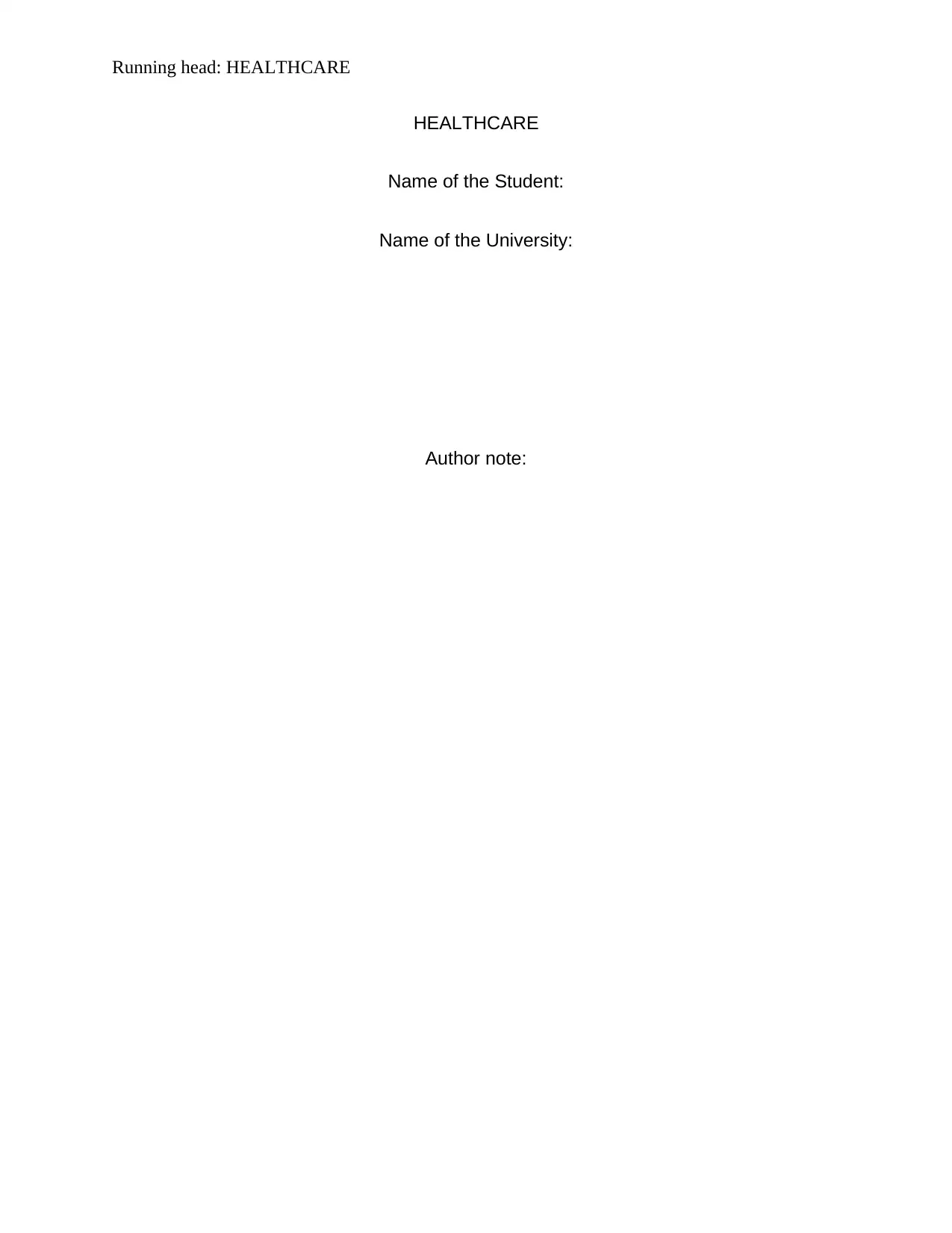
Running head: HEALTHCARE
HEALTHCARE
Name of the Student:
Name of the University:
Author note:
HEALTHCARE
Name of the Student:
Name of the University:
Author note:
Secure Best Marks with AI Grader
Need help grading? Try our AI Grader for instant feedback on your assignments.

1HEALTHCARE
Introduction
Diabetes is identified as a prolonged condition indicated by increasing levels of
glucose in the blood. Main forms of diabetes are known as type-1 Diabetes, type-2
diabetes and gestational diabetes. However, the occurrence of diabetes has been
increasing over the last 3 decades, with rates rising three times over this period.
Reports of Chamberlain et al. (2014) have revealed that diabetes has affected around
1.5 million people in 2015–16. Rates of diabetes are commonly complex among males,
the aged and especially Indigenous Australians as well as inhabitants living in
inaccessible and socioeconomically disadvantaged areas. It is important to note that
type 2 diabetes is identified as highly widespread form of disease, thus resulting to be
highly escapable by maintaining a healthy lifestyle (Adegbija, Hoy and Wang 2015). The
gap between the health of Aboriginal and Torres Strait Islanders and non-Indigenous
Australians is extensively documented with several policies and health initiatives
working with an aim of improving outcomes. However, regardless of these health
initiatives, the rate of life expectancy tends to be around 10-11 years less in comparison
to non-Indigenous Australians with around 65% of life loss prior to 65 years in
comparison to 19% of deaths in the non‐Indigenous population (Aihw.gov.au 2016). The
following report will evaluate the way diabetes has been affecting Indigenous
Australians by focusing on social determinants which have been implemented for this
health issue.
Discussion
Diabetes as a critical health issue among Indigenous Australians
Introduction
Diabetes is identified as a prolonged condition indicated by increasing levels of
glucose in the blood. Main forms of diabetes are known as type-1 Diabetes, type-2
diabetes and gestational diabetes. However, the occurrence of diabetes has been
increasing over the last 3 decades, with rates rising three times over this period.
Reports of Chamberlain et al. (2014) have revealed that diabetes has affected around
1.5 million people in 2015–16. Rates of diabetes are commonly complex among males,
the aged and especially Indigenous Australians as well as inhabitants living in
inaccessible and socioeconomically disadvantaged areas. It is important to note that
type 2 diabetes is identified as highly widespread form of disease, thus resulting to be
highly escapable by maintaining a healthy lifestyle (Adegbija, Hoy and Wang 2015). The
gap between the health of Aboriginal and Torres Strait Islanders and non-Indigenous
Australians is extensively documented with several policies and health initiatives
working with an aim of improving outcomes. However, regardless of these health
initiatives, the rate of life expectancy tends to be around 10-11 years less in comparison
to non-Indigenous Australians with around 65% of life loss prior to 65 years in
comparison to 19% of deaths in the non‐Indigenous population (Aihw.gov.au 2016). The
following report will evaluate the way diabetes has been affecting Indigenous
Australians by focusing on social determinants which have been implemented for this
health issue.
Discussion
Diabetes as a critical health issue among Indigenous Australians
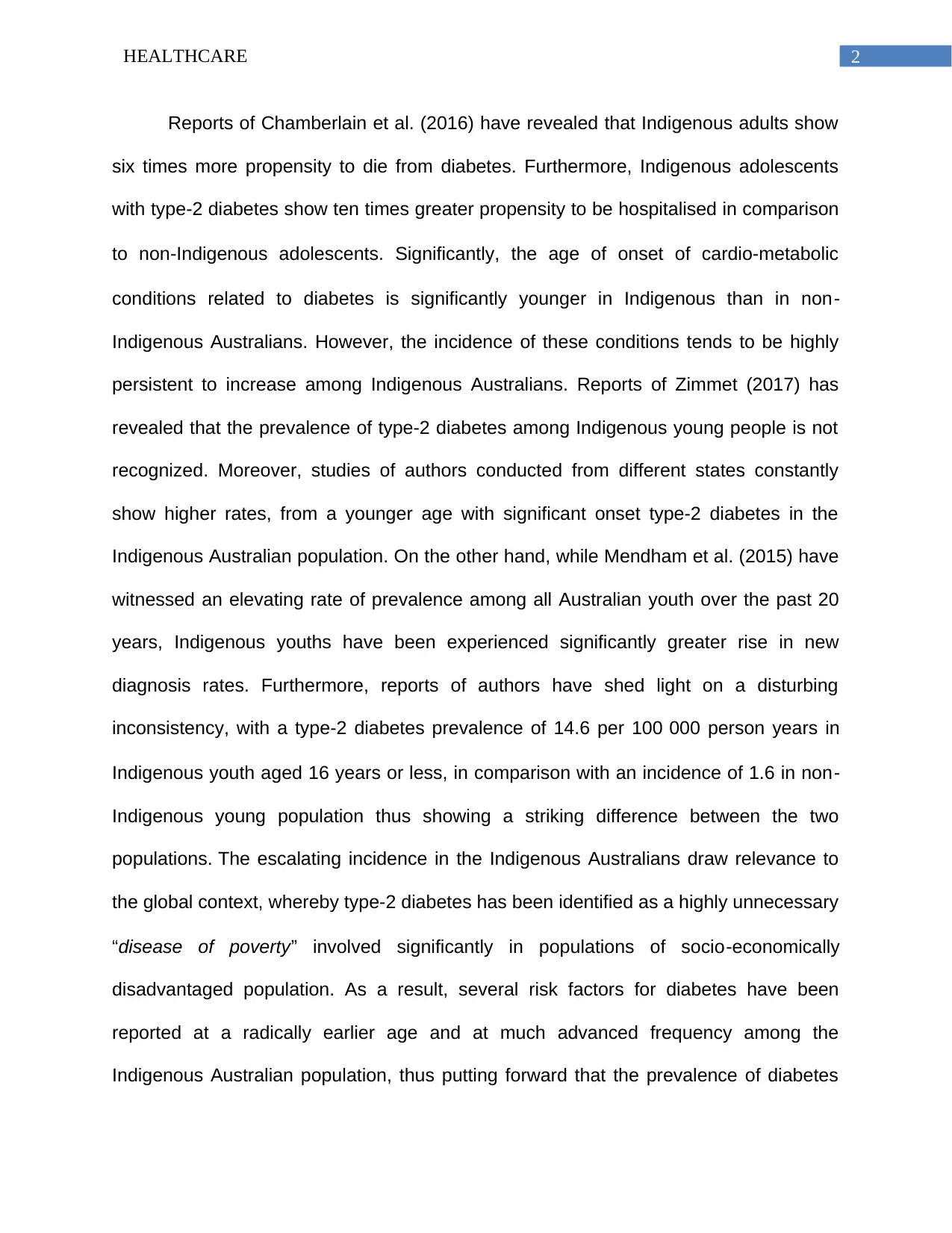
2HEALTHCARE
Reports of Chamberlain et al. (2016) have revealed that Indigenous adults show
six times more propensity to die from diabetes. Furthermore, Indigenous adolescents
with type-2 diabetes show ten times greater propensity to be hospitalised in comparison
to non‐Indigenous adolescents. Significantly, the age of onset of cardio-metabolic
conditions related to diabetes is significantly younger in Indigenous than in non‐
Indigenous Australians. However, the incidence of these conditions tends to be highly
persistent to increase among Indigenous Australians. Reports of Zimmet (2017) has
revealed that the prevalence of type-2 diabetes among Indigenous young people is not
recognized. Moreover, studies of authors conducted from different states constantly
show higher rates, from a younger age with significant onset type-2 diabetes in the
Indigenous Australian population. On the other hand, while Mendham et al. (2015) have
witnessed an elevating rate of prevalence among all Australian youth over the past 20
years, Indigenous youths have been experienced significantly greater rise in new
diagnosis rates. Furthermore, reports of authors have shed light on a disturbing
inconsistency, with a type-2 diabetes prevalence of 14.6 per 100 000 person years in
Indigenous youth aged 16 years or less, in comparison with an incidence of 1.6 in non‐
Indigenous young population thus showing a striking difference between the two
populations. The escalating incidence in the Indigenous Australians draw relevance to
the global context, whereby type-2 diabetes has been identified as a highly unnecessary
“disease of poverty” involved significantly in populations of socio‐economically
disadvantaged population. As a result, several risk factors for diabetes have been
reported at a radically earlier age and at much advanced frequency among the
Indigenous Australian population, thus putting forward that the prevalence of diabetes
Reports of Chamberlain et al. (2016) have revealed that Indigenous adults show
six times more propensity to die from diabetes. Furthermore, Indigenous adolescents
with type-2 diabetes show ten times greater propensity to be hospitalised in comparison
to non‐Indigenous adolescents. Significantly, the age of onset of cardio-metabolic
conditions related to diabetes is significantly younger in Indigenous than in non‐
Indigenous Australians. However, the incidence of these conditions tends to be highly
persistent to increase among Indigenous Australians. Reports of Zimmet (2017) has
revealed that the prevalence of type-2 diabetes among Indigenous young people is not
recognized. Moreover, studies of authors conducted from different states constantly
show higher rates, from a younger age with significant onset type-2 diabetes in the
Indigenous Australian population. On the other hand, while Mendham et al. (2015) have
witnessed an elevating rate of prevalence among all Australian youth over the past 20
years, Indigenous youths have been experienced significantly greater rise in new
diagnosis rates. Furthermore, reports of authors have shed light on a disturbing
inconsistency, with a type-2 diabetes prevalence of 14.6 per 100 000 person years in
Indigenous youth aged 16 years or less, in comparison with an incidence of 1.6 in non‐
Indigenous young population thus showing a striking difference between the two
populations. The escalating incidence in the Indigenous Australians draw relevance to
the global context, whereby type-2 diabetes has been identified as a highly unnecessary
“disease of poverty” involved significantly in populations of socio‐economically
disadvantaged population. As a result, several risk factors for diabetes have been
reported at a radically earlier age and at much advanced frequency among the
Indigenous Australian population, thus putting forward that the prevalence of diabetes

3HEALTHCARE
shows an implication of increasing exponentially in the future without intervention
(McDermott et al. 2015).
Socio-Economic Status Contributing to Diabetes among Indigenous Australians
Healthy lifestyles are thought to be dejected in the deficiency of an environment,
which advocates them in addition to behavioural, and educational interventions may be
considerably diminish or rendered ineffective in such non-enabling environment.
Reports of Matthews et al. (2014) have revealed that in Australia, the increasing figure
of Indigenous individuals suffering from type-2 diabetes is significantly driven by
escalating rates of obesity with reduced rates of physical movement, nutritional
alterations as well as an ageing populace. Aboriginal Australians persistent suffering
from diabetes caused due to their traditional unhealthy lifestyle that further leads to
chronic heart and blood vessel disease in addition to obesity or high blood pressure. On
the other hand, research conducted by McGuire, Anderson and Fulbrook (2014) have
advocated that the metabolism of Indigenous Australians has been pushed towards
developing them into capable hunter-gatherers, which made them proficient in living a
traditional lifestyle. However, recently with less Aboriginal people living an old-style
lifestyle and further being extremely susceptible towards current Westernized lifestyle,
Indigenous Australians have been inclining towards consumption of foods. These foods
are low in fibre and rich in fat and sugar, alcohol, cigarette smoking along with an
inactive lifestyle that has led them to lose their once-efficient digestion and thus
increasing incidence of Type-2 diabetes. Maple‐Brown et al. (2014) have indicated that
Aboriginal people living Westernised lifestyle tend to have elevated rates of obesity with
impaired glucose tolerance in addition to high blood pressure, elevated levels of
shows an implication of increasing exponentially in the future without intervention
(McDermott et al. 2015).
Socio-Economic Status Contributing to Diabetes among Indigenous Australians
Healthy lifestyles are thought to be dejected in the deficiency of an environment,
which advocates them in addition to behavioural, and educational interventions may be
considerably diminish or rendered ineffective in such non-enabling environment.
Reports of Matthews et al. (2014) have revealed that in Australia, the increasing figure
of Indigenous individuals suffering from type-2 diabetes is significantly driven by
escalating rates of obesity with reduced rates of physical movement, nutritional
alterations as well as an ageing populace. Aboriginal Australians persistent suffering
from diabetes caused due to their traditional unhealthy lifestyle that further leads to
chronic heart and blood vessel disease in addition to obesity or high blood pressure. On
the other hand, research conducted by McGuire, Anderson and Fulbrook (2014) have
advocated that the metabolism of Indigenous Australians has been pushed towards
developing them into capable hunter-gatherers, which made them proficient in living a
traditional lifestyle. However, recently with less Aboriginal people living an old-style
lifestyle and further being extremely susceptible towards current Westernized lifestyle,
Indigenous Australians have been inclining towards consumption of foods. These foods
are low in fibre and rich in fat and sugar, alcohol, cigarette smoking along with an
inactive lifestyle that has led them to lose their once-efficient digestion and thus
increasing incidence of Type-2 diabetes. Maple‐Brown et al. (2014) have indicated that
Aboriginal people living Westernised lifestyle tend to have elevated rates of obesity with
impaired glucose tolerance in addition to high blood pressure, elevated levels of
Secure Best Marks with AI Grader
Need help grading? Try our AI Grader for instant feedback on your assignments.
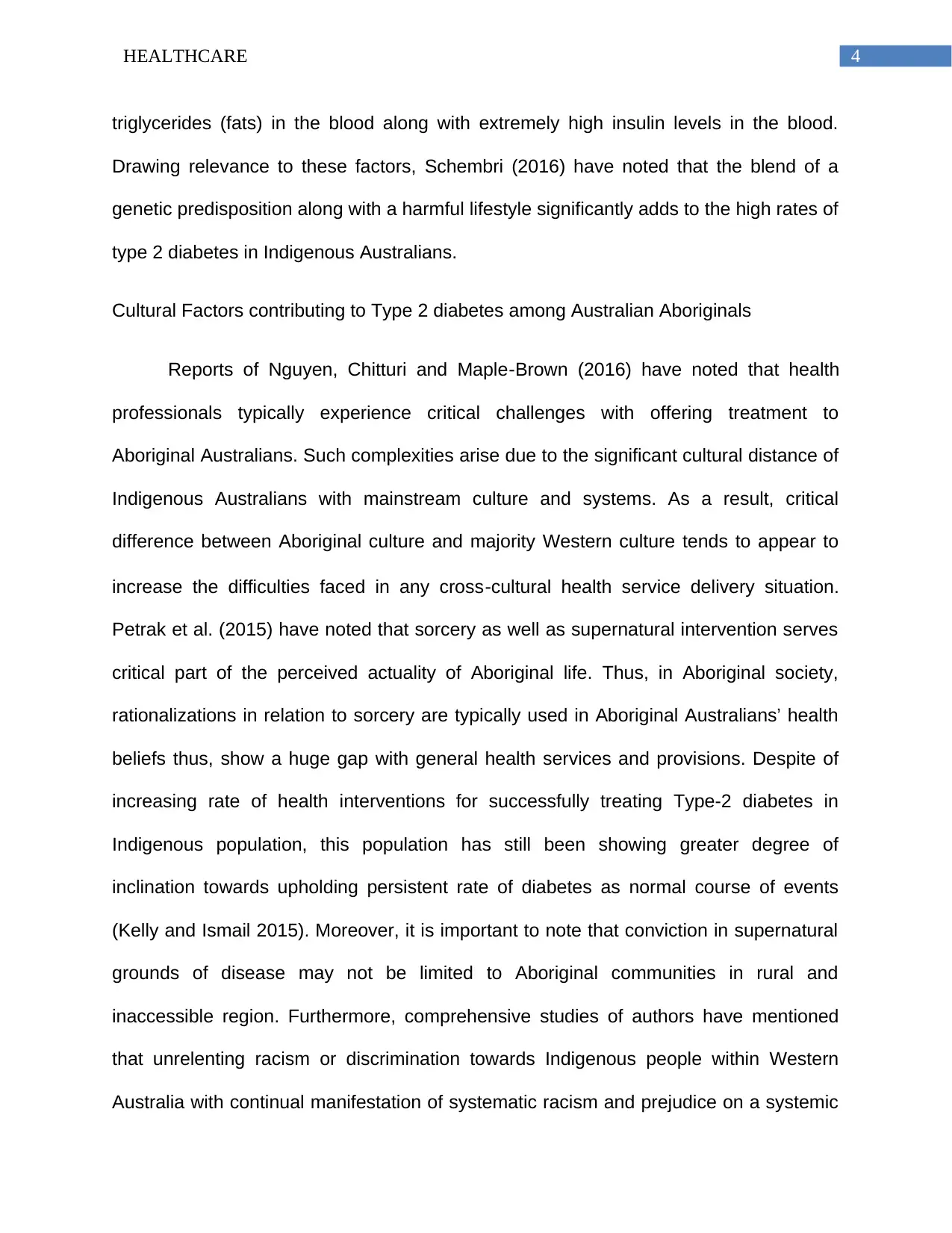
4HEALTHCARE
triglycerides (fats) in the blood along with extremely high insulin levels in the blood.
Drawing relevance to these factors, Schembri (2016) have noted that the blend of a
genetic predisposition along with a harmful lifestyle significantly adds to the high rates of
type 2 diabetes in Indigenous Australians.
Cultural Factors contributing to Type 2 diabetes among Australian Aboriginals
Reports of Nguyen, Chitturi and Maple‐Brown (2016) have noted that health
professionals typically experience critical challenges with offering treatment to
Aboriginal Australians. Such complexities arise due to the significant cultural distance of
Indigenous Australians with mainstream culture and systems. As a result, critical
difference between Aboriginal culture and majority Western culture tends to appear to
increase the difficulties faced in any cross‐cultural health service delivery situation.
Petrak et al. (2015) have noted that sorcery as well as supernatural intervention serves
critical part of the perceived actuality of Aboriginal life. Thus, in Aboriginal society,
rationalizations in relation to sorcery are typically used in Aboriginal Australians’ health
beliefs thus, show a huge gap with general health services and provisions. Despite of
increasing rate of health interventions for successfully treating Type-2 diabetes in
Indigenous population, this population has still been showing greater degree of
inclination towards upholding persistent rate of diabetes as normal course of events
(Kelly and Ismail 2015). Moreover, it is important to note that conviction in supernatural
grounds of disease may not be limited to Aboriginal communities in rural and
inaccessible region. Furthermore, comprehensive studies of authors have mentioned
that unrelenting racism or discrimination towards Indigenous people within Western
Australia with continual manifestation of systematic racism and prejudice on a systemic
triglycerides (fats) in the blood along with extremely high insulin levels in the blood.
Drawing relevance to these factors, Schembri (2016) have noted that the blend of a
genetic predisposition along with a harmful lifestyle significantly adds to the high rates of
type 2 diabetes in Indigenous Australians.
Cultural Factors contributing to Type 2 diabetes among Australian Aboriginals
Reports of Nguyen, Chitturi and Maple‐Brown (2016) have noted that health
professionals typically experience critical challenges with offering treatment to
Aboriginal Australians. Such complexities arise due to the significant cultural distance of
Indigenous Australians with mainstream culture and systems. As a result, critical
difference between Aboriginal culture and majority Western culture tends to appear to
increase the difficulties faced in any cross‐cultural health service delivery situation.
Petrak et al. (2015) have noted that sorcery as well as supernatural intervention serves
critical part of the perceived actuality of Aboriginal life. Thus, in Aboriginal society,
rationalizations in relation to sorcery are typically used in Aboriginal Australians’ health
beliefs thus, show a huge gap with general health services and provisions. Despite of
increasing rate of health interventions for successfully treating Type-2 diabetes in
Indigenous population, this population has still been showing greater degree of
inclination towards upholding persistent rate of diabetes as normal course of events
(Kelly and Ismail 2015). Moreover, it is important to note that conviction in supernatural
grounds of disease may not be limited to Aboriginal communities in rural and
inaccessible region. Furthermore, comprehensive studies of authors have mentioned
that unrelenting racism or discrimination towards Indigenous people within Western
Australia with continual manifestation of systematic racism and prejudice on a systemic
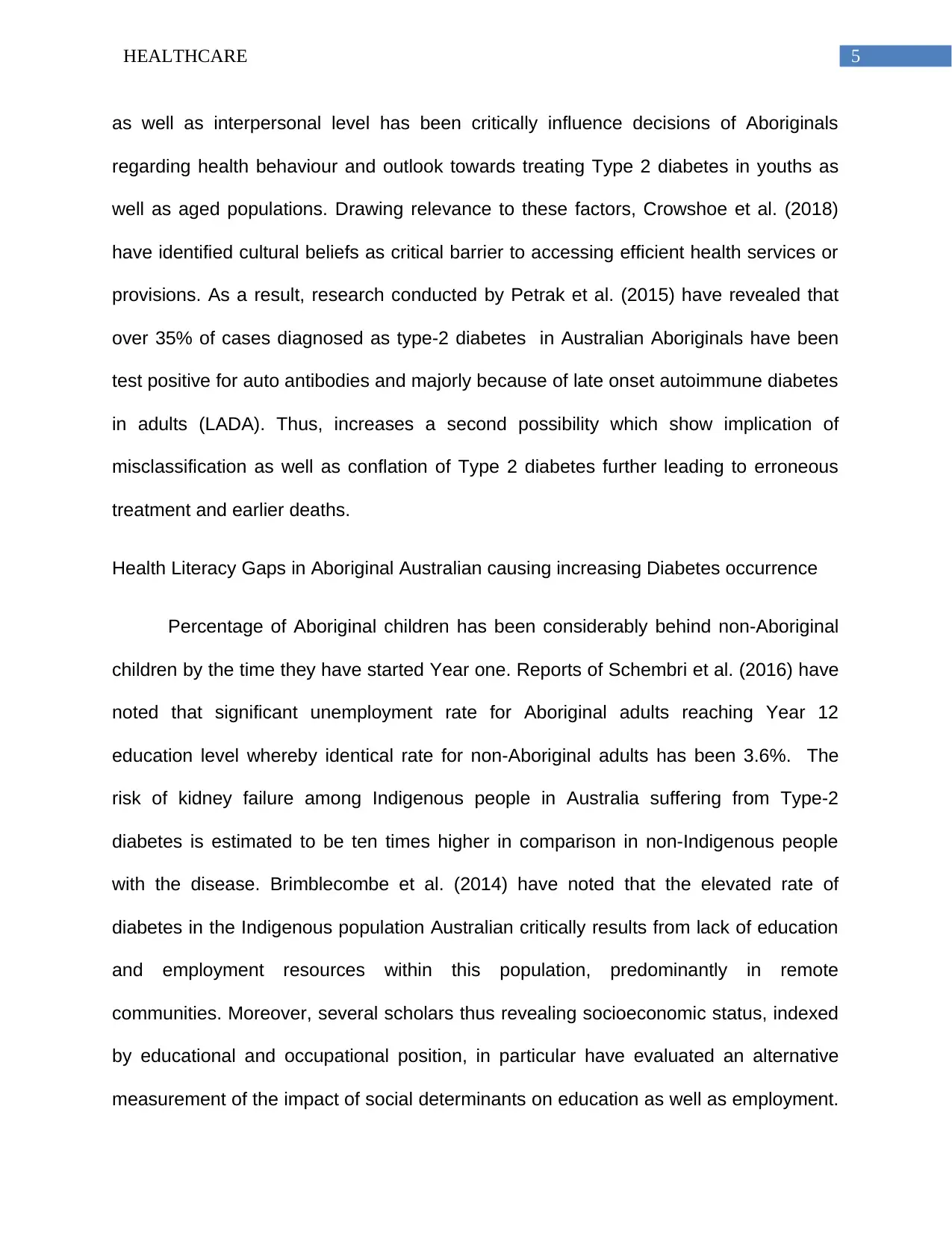
5HEALTHCARE
as well as interpersonal level has been critically influence decisions of Aboriginals
regarding health behaviour and outlook towards treating Type 2 diabetes in youths as
well as aged populations. Drawing relevance to these factors, Crowshoe et al. (2018)
have identified cultural beliefs as critical barrier to accessing efficient health services or
provisions. As a result, research conducted by Petrak et al. (2015) have revealed that
over 35% of cases diagnosed as type-2 diabetes in Australian Aboriginals have been
test positive for auto antibodies and majorly because of late onset autoimmune diabetes
in adults (LADA). Thus, increases a second possibility which show implication of
misclassification as well as conflation of Type 2 diabetes further leading to erroneous
treatment and earlier deaths.
Health Literacy Gaps in Aboriginal Australian causing increasing Diabetes occurrence
Percentage of Aboriginal children has been considerably behind non-Aboriginal
children by the time they have started Year one. Reports of Schembri et al. (2016) have
noted that significant unemployment rate for Aboriginal adults reaching Year 12
education level whereby identical rate for non-Aboriginal adults has been 3.6%. The
risk of kidney failure among Indigenous people in Australia suffering from Type-2
diabetes is estimated to be ten times higher in comparison in non-Indigenous people
with the disease. Brimblecombe et al. (2014) have noted that the elevated rate of
diabetes in the Indigenous population Australian critically results from lack of education
and employment resources within this population, predominantly in remote
communities. Moreover, several scholars thus revealing socioeconomic status, indexed
by educational and occupational position, in particular have evaluated an alternative
measurement of the impact of social determinants on education as well as employment.
as well as interpersonal level has been critically influence decisions of Aboriginals
regarding health behaviour and outlook towards treating Type 2 diabetes in youths as
well as aged populations. Drawing relevance to these factors, Crowshoe et al. (2018)
have identified cultural beliefs as critical barrier to accessing efficient health services or
provisions. As a result, research conducted by Petrak et al. (2015) have revealed that
over 35% of cases diagnosed as type-2 diabetes in Australian Aboriginals have been
test positive for auto antibodies and majorly because of late onset autoimmune diabetes
in adults (LADA). Thus, increases a second possibility which show implication of
misclassification as well as conflation of Type 2 diabetes further leading to erroneous
treatment and earlier deaths.
Health Literacy Gaps in Aboriginal Australian causing increasing Diabetes occurrence
Percentage of Aboriginal children has been considerably behind non-Aboriginal
children by the time they have started Year one. Reports of Schembri et al. (2016) have
noted that significant unemployment rate for Aboriginal adults reaching Year 12
education level whereby identical rate for non-Aboriginal adults has been 3.6%. The
risk of kidney failure among Indigenous people in Australia suffering from Type-2
diabetes is estimated to be ten times higher in comparison in non-Indigenous people
with the disease. Brimblecombe et al. (2014) have noted that the elevated rate of
diabetes in the Indigenous population Australian critically results from lack of education
and employment resources within this population, predominantly in remote
communities. Moreover, several scholars thus revealing socioeconomic status, indexed
by educational and occupational position, in particular have evaluated an alternative
measurement of the impact of social determinants on education as well as employment.
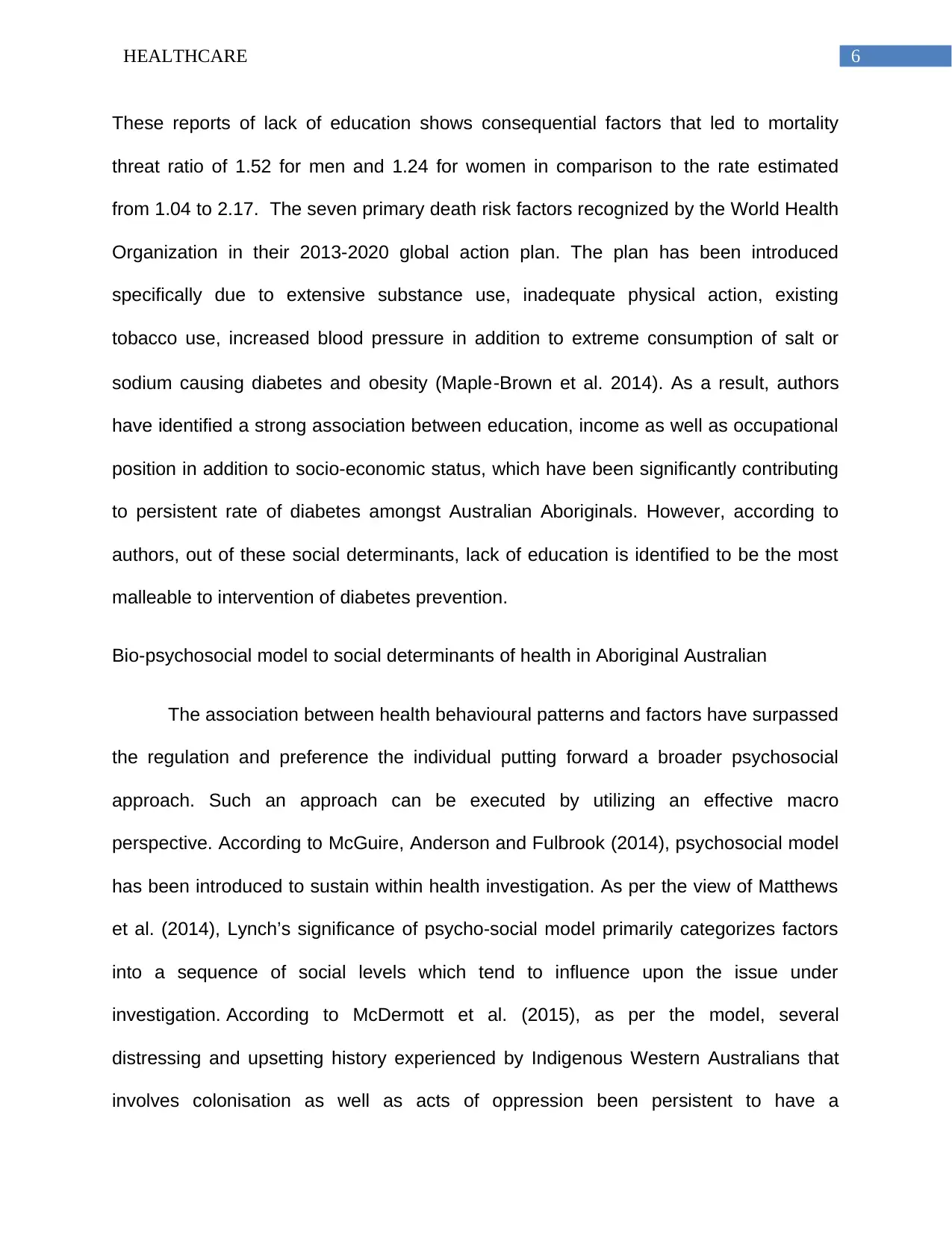
6HEALTHCARE
These reports of lack of education shows consequential factors that led to mortality
threat ratio of 1.52 for men and 1.24 for women in comparison to the rate estimated
from 1.04 to 2.17. The seven primary death risk factors recognized by the World Health
Organization in their 2013-2020 global action plan. The plan has been introduced
specifically due to extensive substance use, inadequate physical action, existing
tobacco use, increased blood pressure in addition to extreme consumption of salt or
sodium causing diabetes and obesity (Maple‐Brown et al. 2014). As a result, authors
have identified a strong association between education, income as well as occupational
position in addition to socio-economic status, which have been significantly contributing
to persistent rate of diabetes amongst Australian Aboriginals. However, according to
authors, out of these social determinants, lack of education is identified to be the most
malleable to intervention of diabetes prevention.
Bio-psychosocial model to social determinants of health in Aboriginal Australian
The association between health behavioural patterns and factors have surpassed
the regulation and preference the individual putting forward a broader psychosocial
approach. Such an approach can be executed by utilizing an effective macro
perspective. According to McGuire, Anderson and Fulbrook (2014), psychosocial model
has been introduced to sustain within health investigation. As per the view of Matthews
et al. (2014), Lynch’s significance of psycho-social model primarily categorizes factors
into a sequence of social levels which tend to influence upon the issue under
investigation. According to McDermott et al. (2015), as per the model, several
distressing and upsetting history experienced by Indigenous Western Australians that
involves colonisation as well as acts of oppression been persistent to have a
These reports of lack of education shows consequential factors that led to mortality
threat ratio of 1.52 for men and 1.24 for women in comparison to the rate estimated
from 1.04 to 2.17. The seven primary death risk factors recognized by the World Health
Organization in their 2013-2020 global action plan. The plan has been introduced
specifically due to extensive substance use, inadequate physical action, existing
tobacco use, increased blood pressure in addition to extreme consumption of salt or
sodium causing diabetes and obesity (Maple‐Brown et al. 2014). As a result, authors
have identified a strong association between education, income as well as occupational
position in addition to socio-economic status, which have been significantly contributing
to persistent rate of diabetes amongst Australian Aboriginals. However, according to
authors, out of these social determinants, lack of education is identified to be the most
malleable to intervention of diabetes prevention.
Bio-psychosocial model to social determinants of health in Aboriginal Australian
The association between health behavioural patterns and factors have surpassed
the regulation and preference the individual putting forward a broader psychosocial
approach. Such an approach can be executed by utilizing an effective macro
perspective. According to McGuire, Anderson and Fulbrook (2014), psychosocial model
has been introduced to sustain within health investigation. As per the view of Matthews
et al. (2014), Lynch’s significance of psycho-social model primarily categorizes factors
into a sequence of social levels which tend to influence upon the issue under
investigation. According to McDermott et al. (2015), as per the model, several
distressing and upsetting history experienced by Indigenous Western Australians that
involves colonisation as well as acts of oppression been persistent to have a
Paraphrase This Document
Need a fresh take? Get an instant paraphrase of this document with our AI Paraphraser
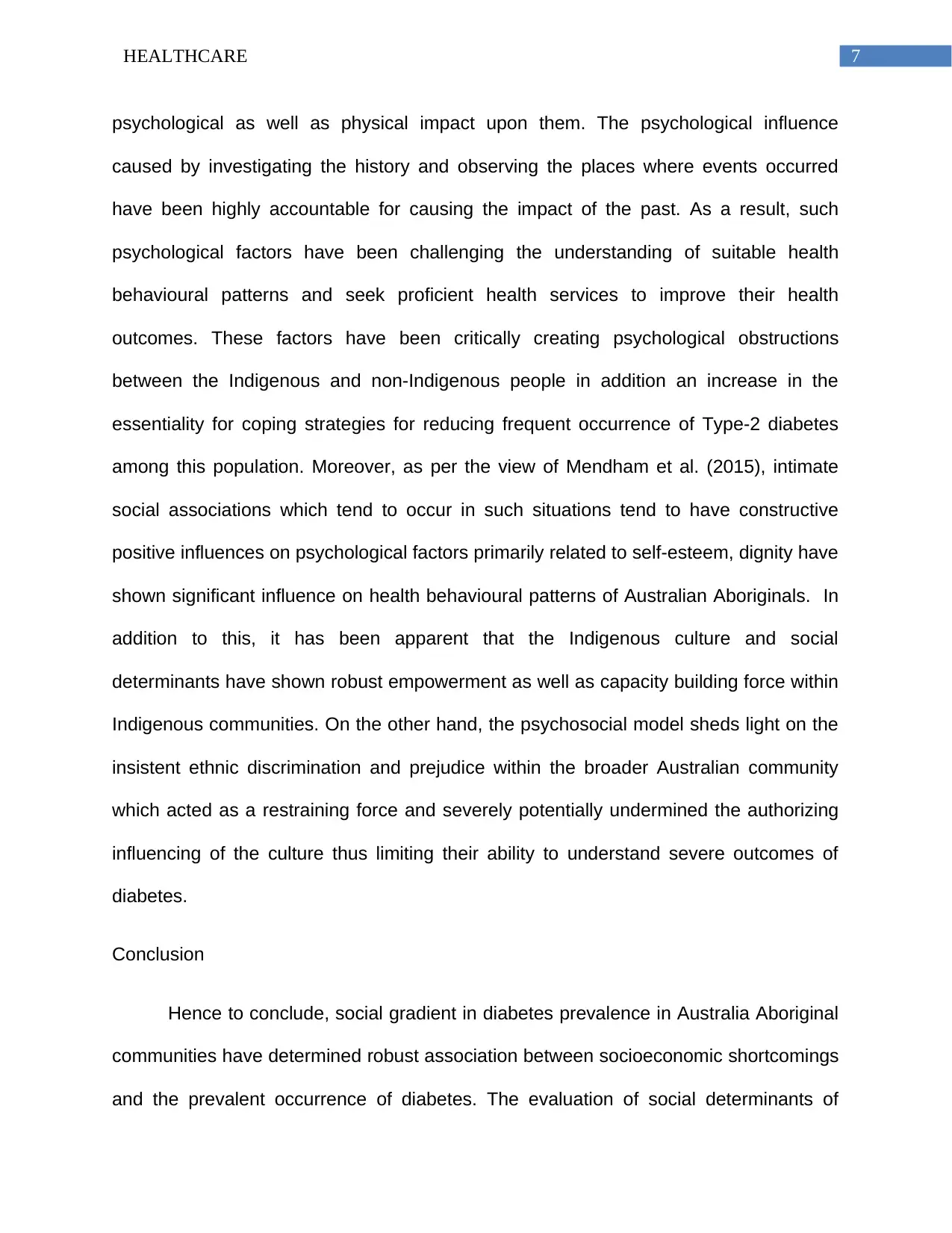
7HEALTHCARE
psychological as well as physical impact upon them. The psychological influence
caused by investigating the history and observing the places where events occurred
have been highly accountable for causing the impact of the past. As a result, such
psychological factors have been challenging the understanding of suitable health
behavioural patterns and seek proficient health services to improve their health
outcomes. These factors have been critically creating psychological obstructions
between the Indigenous and non-Indigenous people in addition an increase in the
essentiality for coping strategies for reducing frequent occurrence of Type-2 diabetes
among this population. Moreover, as per the view of Mendham et al. (2015), intimate
social associations which tend to occur in such situations tend to have constructive
positive influences on psychological factors primarily related to self-esteem, dignity have
shown significant influence on health behavioural patterns of Australian Aboriginals. In
addition to this, it has been apparent that the Indigenous culture and social
determinants have shown robust empowerment as well as capacity building force within
Indigenous communities. On the other hand, the psychosocial model sheds light on the
insistent ethnic discrimination and prejudice within the broader Australian community
which acted as a restraining force and severely potentially undermined the authorizing
influencing of the culture thus limiting their ability to understand severe outcomes of
diabetes.
Conclusion
Hence to conclude, social gradient in diabetes prevalence in Australia Aboriginal
communities have determined robust association between socioeconomic shortcomings
and the prevalent occurrence of diabetes. The evaluation of social determinants of
psychological as well as physical impact upon them. The psychological influence
caused by investigating the history and observing the places where events occurred
have been highly accountable for causing the impact of the past. As a result, such
psychological factors have been challenging the understanding of suitable health
behavioural patterns and seek proficient health services to improve their health
outcomes. These factors have been critically creating psychological obstructions
between the Indigenous and non-Indigenous people in addition an increase in the
essentiality for coping strategies for reducing frequent occurrence of Type-2 diabetes
among this population. Moreover, as per the view of Mendham et al. (2015), intimate
social associations which tend to occur in such situations tend to have constructive
positive influences on psychological factors primarily related to self-esteem, dignity have
shown significant influence on health behavioural patterns of Australian Aboriginals. In
addition to this, it has been apparent that the Indigenous culture and social
determinants have shown robust empowerment as well as capacity building force within
Indigenous communities. On the other hand, the psychosocial model sheds light on the
insistent ethnic discrimination and prejudice within the broader Australian community
which acted as a restraining force and severely potentially undermined the authorizing
influencing of the culture thus limiting their ability to understand severe outcomes of
diabetes.
Conclusion
Hence to conclude, social gradient in diabetes prevalence in Australia Aboriginal
communities have determined robust association between socioeconomic shortcomings
and the prevalent occurrence of diabetes. The evaluation of social determinants of
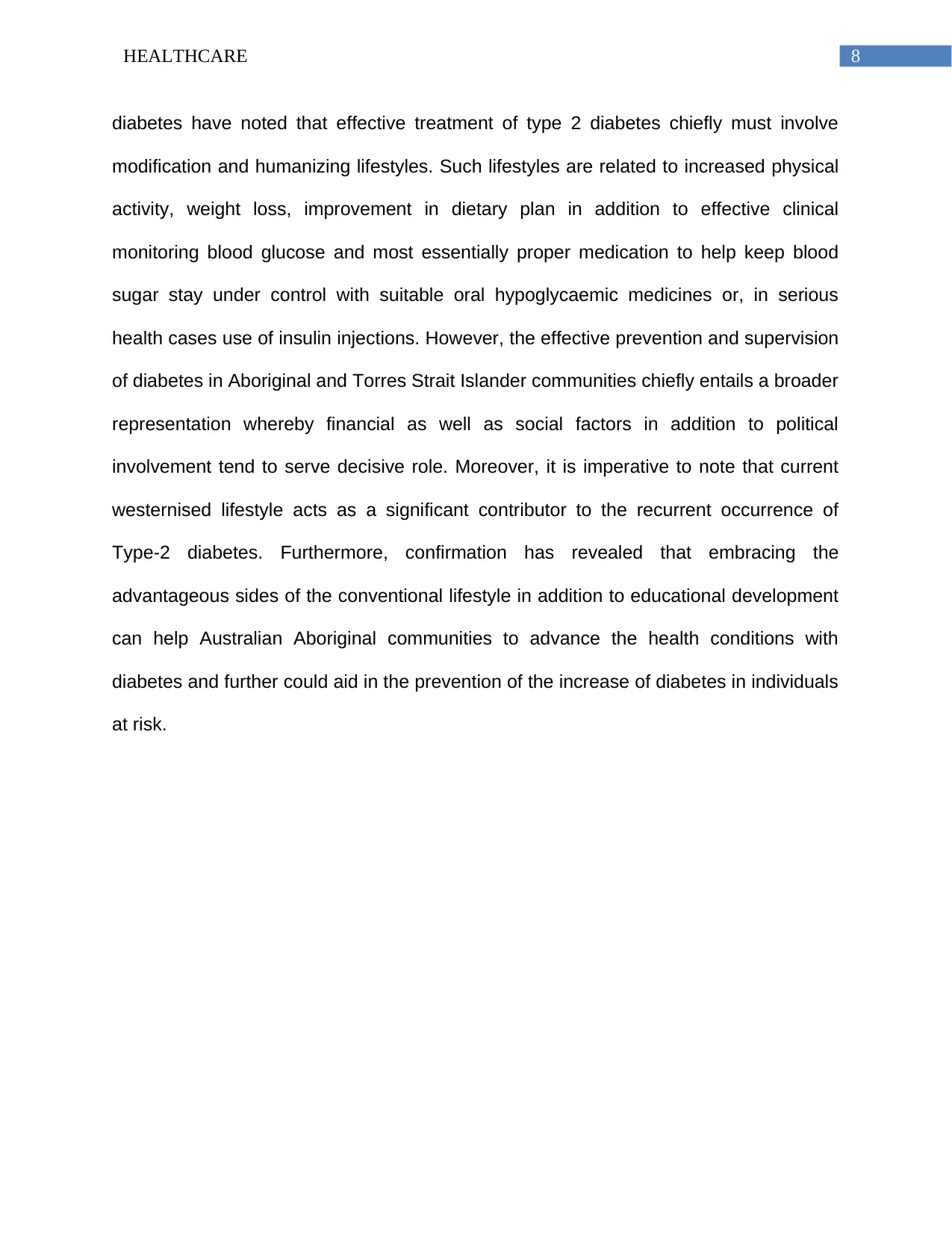
8HEALTHCARE
diabetes have noted that effective treatment of type 2 diabetes chiefly must involve
modification and humanizing lifestyles. Such lifestyles are related to increased physical
activity, weight loss, improvement in dietary plan in addition to effective clinical
monitoring blood glucose and most essentially proper medication to help keep blood
sugar stay under control with suitable oral hypoglycaemic medicines or, in serious
health cases use of insulin injections. However, the effective prevention and supervision
of diabetes in Aboriginal and Torres Strait Islander communities chiefly entails a broader
representation whereby financial as well as social factors in addition to political
involvement tend to serve decisive role. Moreover, it is imperative to note that current
westernised lifestyle acts as a significant contributor to the recurrent occurrence of
Type-2 diabetes. Furthermore, confirmation has revealed that embracing the
advantageous sides of the conventional lifestyle in addition to educational development
can help Australian Aboriginal communities to advance the health conditions with
diabetes and further could aid in the prevention of the increase of diabetes in individuals
at risk.
diabetes have noted that effective treatment of type 2 diabetes chiefly must involve
modification and humanizing lifestyles. Such lifestyles are related to increased physical
activity, weight loss, improvement in dietary plan in addition to effective clinical
monitoring blood glucose and most essentially proper medication to help keep blood
sugar stay under control with suitable oral hypoglycaemic medicines or, in serious
health cases use of insulin injections. However, the effective prevention and supervision
of diabetes in Aboriginal and Torres Strait Islander communities chiefly entails a broader
representation whereby financial as well as social factors in addition to political
involvement tend to serve decisive role. Moreover, it is imperative to note that current
westernised lifestyle acts as a significant contributor to the recurrent occurrence of
Type-2 diabetes. Furthermore, confirmation has revealed that embracing the
advantageous sides of the conventional lifestyle in addition to educational development
can help Australian Aboriginal communities to advance the health conditions with
diabetes and further could aid in the prevention of the increase of diabetes in individuals
at risk.
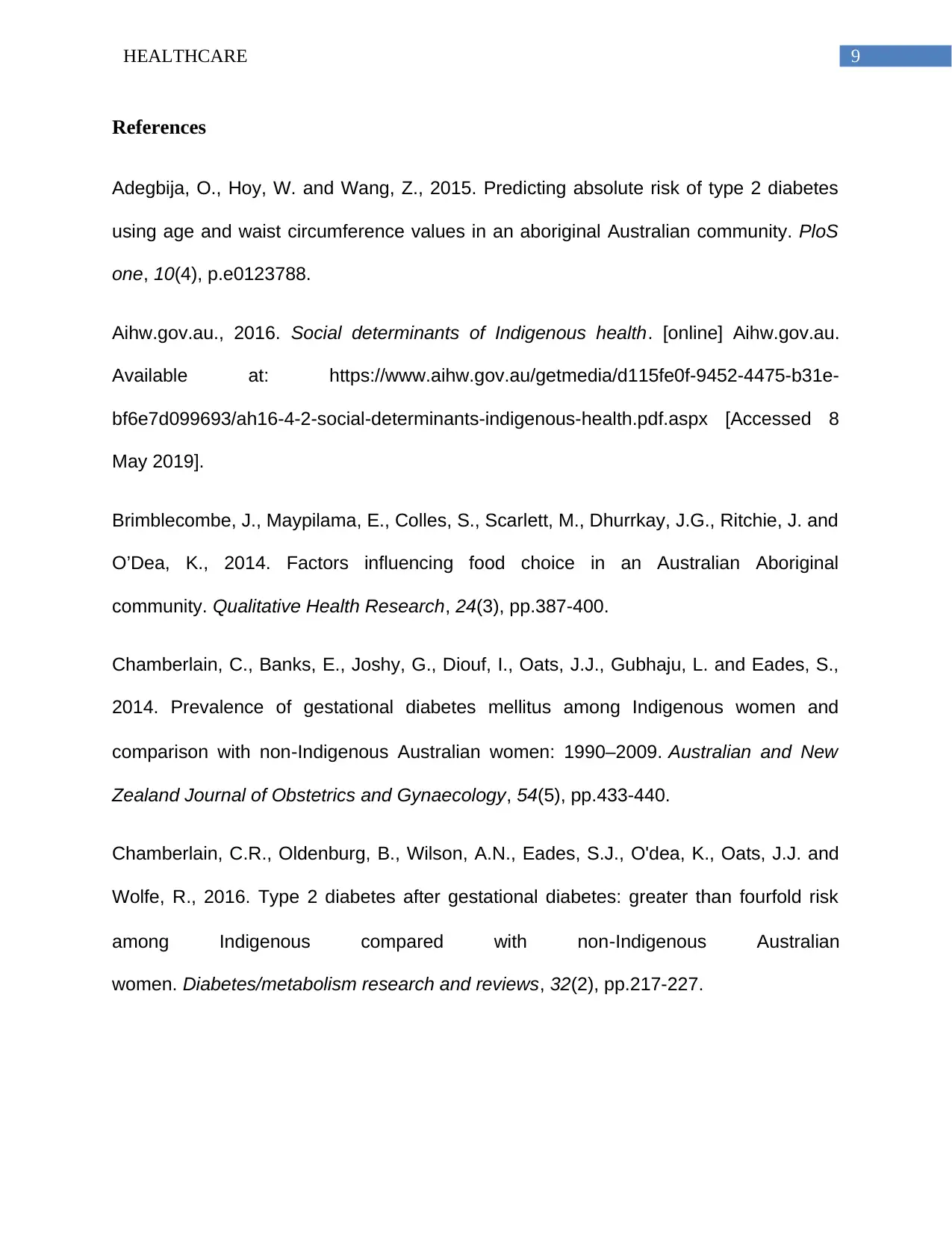
9HEALTHCARE
References
Adegbija, O., Hoy, W. and Wang, Z., 2015. Predicting absolute risk of type 2 diabetes
using age and waist circumference values in an aboriginal Australian community. PloS
one, 10(4), p.e0123788.
Aihw.gov.au., 2016. Social determinants of Indigenous health. [online] Aihw.gov.au.
Available at: https://www.aihw.gov.au/getmedia/d115fe0f-9452-4475-b31e-
bf6e7d099693/ah16-4-2-social-determinants-indigenous-health.pdf.aspx [Accessed 8
May 2019].
Brimblecombe, J., Maypilama, E., Colles, S., Scarlett, M., Dhurrkay, J.G., Ritchie, J. and
O’Dea, K., 2014. Factors influencing food choice in an Australian Aboriginal
community. Qualitative Health Research, 24(3), pp.387-400.
Chamberlain, C., Banks, E., Joshy, G., Diouf, I., Oats, J.J., Gubhaju, L. and Eades, S.,
2014. Prevalence of gestational diabetes mellitus among Indigenous women and
comparison with non‐Indigenous Australian women: 1990–2009. Australian and New
Zealand Journal of Obstetrics and Gynaecology, 54(5), pp.433-440.
Chamberlain, C.R., Oldenburg, B., Wilson, A.N., Eades, S.J., O'dea, K., Oats, J.J. and
Wolfe, R., 2016. Type 2 diabetes after gestational diabetes: greater than fourfold risk
among Indigenous compared with non‐Indigenous Australian
women. Diabetes/metabolism research and reviews, 32(2), pp.217-227.
References
Adegbija, O., Hoy, W. and Wang, Z., 2015. Predicting absolute risk of type 2 diabetes
using age and waist circumference values in an aboriginal Australian community. PloS
one, 10(4), p.e0123788.
Aihw.gov.au., 2016. Social determinants of Indigenous health. [online] Aihw.gov.au.
Available at: https://www.aihw.gov.au/getmedia/d115fe0f-9452-4475-b31e-
bf6e7d099693/ah16-4-2-social-determinants-indigenous-health.pdf.aspx [Accessed 8
May 2019].
Brimblecombe, J., Maypilama, E., Colles, S., Scarlett, M., Dhurrkay, J.G., Ritchie, J. and
O’Dea, K., 2014. Factors influencing food choice in an Australian Aboriginal
community. Qualitative Health Research, 24(3), pp.387-400.
Chamberlain, C., Banks, E., Joshy, G., Diouf, I., Oats, J.J., Gubhaju, L. and Eades, S.,
2014. Prevalence of gestational diabetes mellitus among Indigenous women and
comparison with non‐Indigenous Australian women: 1990–2009. Australian and New
Zealand Journal of Obstetrics and Gynaecology, 54(5), pp.433-440.
Chamberlain, C.R., Oldenburg, B., Wilson, A.N., Eades, S.J., O'dea, K., Oats, J.J. and
Wolfe, R., 2016. Type 2 diabetes after gestational diabetes: greater than fourfold risk
among Indigenous compared with non‐Indigenous Australian
women. Diabetes/metabolism research and reviews, 32(2), pp.217-227.
Secure Best Marks with AI Grader
Need help grading? Try our AI Grader for instant feedback on your assignments.

10HEALTHCARE
Crowshoe, L., Dannenbaum, D., Green, M., Henderson, R., Hayward, M.N. and Toth,
E., 2018. Type 2 diabetes and Indigenous peoples. Canadian journal of diabetes, 42,
pp.S296-S306.
Kelly, S.J. and Ismail, M., 2015. Stress and type 2 diabetes: a review of how stress
contributes to the development of type 2 diabetes. Annual review of public health, 36,
pp.441-462.
Maple‐Brown, L.J., Ekinci, E.I., Hughes, J.T., Chatfield, M., Lawton, P.D., Jones,
G.R.D., Ellis, A.G., Sinha, A., Cass, A., Hoy, W.E. and O'dea, K., 2014. Performance of
formulas for estimating glomerular filtration rate in Indigenous Australians with and
without Type 2 diabetes: the eGFR Study. Diabetic medicine, 31(7), pp.829-838.
Matthews, V., Schierhout, G., McBroom, J., Connors, C., Kennedy, C., Kwedza, R.,
Larkins, S., Moore, E., Thompson, S., Scrimgeour, D. and Bailie, R., 2014. Duration of
participation in continuous quality improvement: a key factor explaining improved
delivery of Type 2 diabetes services. BMC health services research, 14(1), p.578.
McDermott, R.A., Schmidt, B., Preece, C., Owens, V., Taylor, S., Li, M. and Esterman,
A., 2015. Community health workers improve diabetes care in remote Australian
Indigenous communities: results of a pragmatic cluster randomized controlled
trial. BMC health services research, 15(1), p.68.
McGuire, A.M., Anderson, D.J. and Fulbrook, P., 2014. Perceived barriers to healthy
lifestyle activities in midlife and older Australian women with type 2
diabetes. Collegian, 21(4), pp.301-310.
Crowshoe, L., Dannenbaum, D., Green, M., Henderson, R., Hayward, M.N. and Toth,
E., 2018. Type 2 diabetes and Indigenous peoples. Canadian journal of diabetes, 42,
pp.S296-S306.
Kelly, S.J. and Ismail, M., 2015. Stress and type 2 diabetes: a review of how stress
contributes to the development of type 2 diabetes. Annual review of public health, 36,
pp.441-462.
Maple‐Brown, L.J., Ekinci, E.I., Hughes, J.T., Chatfield, M., Lawton, P.D., Jones,
G.R.D., Ellis, A.G., Sinha, A., Cass, A., Hoy, W.E. and O'dea, K., 2014. Performance of
formulas for estimating glomerular filtration rate in Indigenous Australians with and
without Type 2 diabetes: the eGFR Study. Diabetic medicine, 31(7), pp.829-838.
Matthews, V., Schierhout, G., McBroom, J., Connors, C., Kennedy, C., Kwedza, R.,
Larkins, S., Moore, E., Thompson, S., Scrimgeour, D. and Bailie, R., 2014. Duration of
participation in continuous quality improvement: a key factor explaining improved
delivery of Type 2 diabetes services. BMC health services research, 14(1), p.578.
McDermott, R.A., Schmidt, B., Preece, C., Owens, V., Taylor, S., Li, M. and Esterman,
A., 2015. Community health workers improve diabetes care in remote Australian
Indigenous communities: results of a pragmatic cluster randomized controlled
trial. BMC health services research, 15(1), p.68.
McGuire, A.M., Anderson, D.J. and Fulbrook, P., 2014. Perceived barriers to healthy
lifestyle activities in midlife and older Australian women with type 2
diabetes. Collegian, 21(4), pp.301-310.
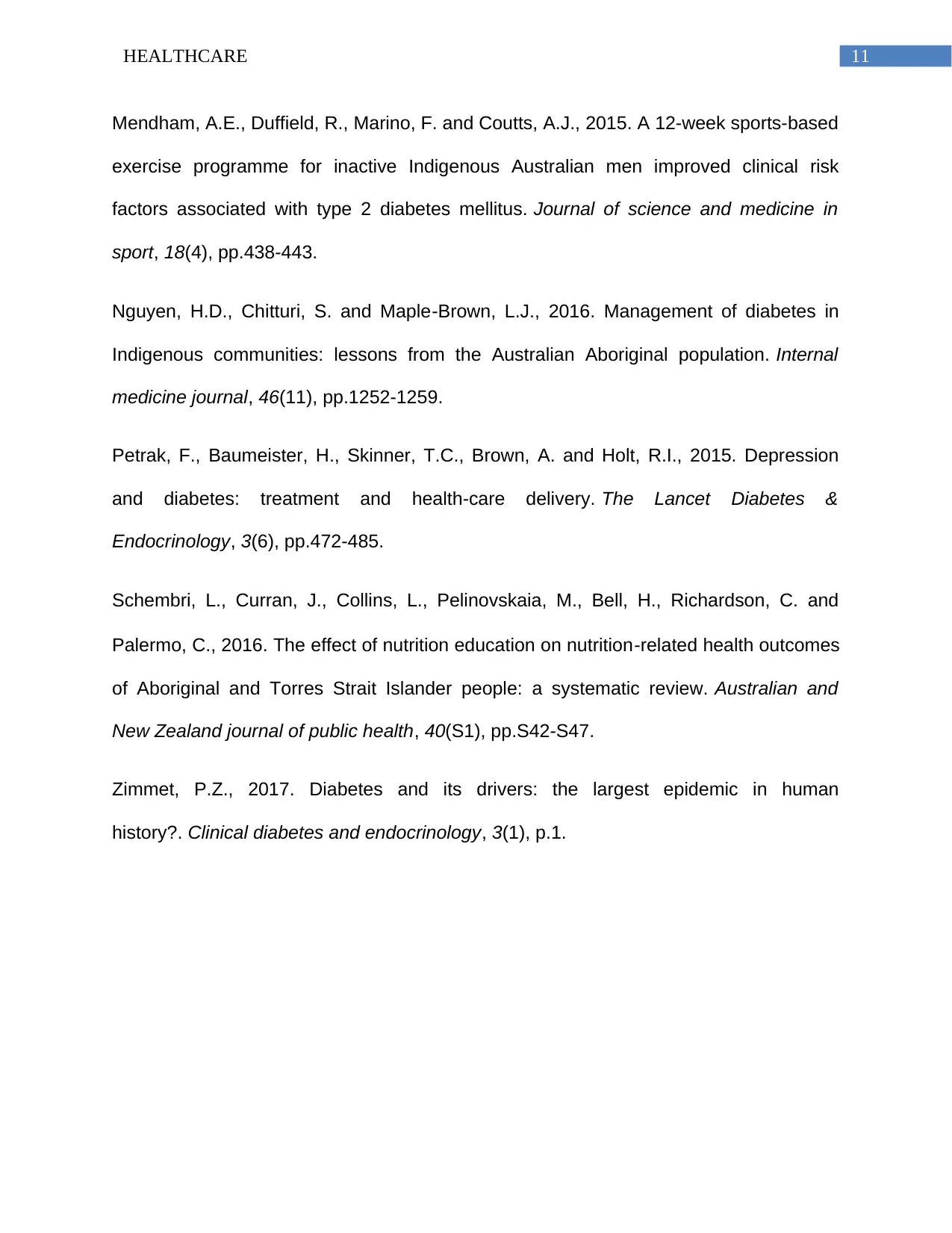
11HEALTHCARE
Mendham, A.E., Duffield, R., Marino, F. and Coutts, A.J., 2015. A 12-week sports-based
exercise programme for inactive Indigenous Australian men improved clinical risk
factors associated with type 2 diabetes mellitus. Journal of science and medicine in
sport, 18(4), pp.438-443.
Nguyen, H.D., Chitturi, S. and Maple‐Brown, L.J., 2016. Management of diabetes in
Indigenous communities: lessons from the Australian Aboriginal population. Internal
medicine journal, 46(11), pp.1252-1259.
Petrak, F., Baumeister, H., Skinner, T.C., Brown, A. and Holt, R.I., 2015. Depression
and diabetes: treatment and health-care delivery. The Lancet Diabetes &
Endocrinology, 3(6), pp.472-485.
Schembri, L., Curran, J., Collins, L., Pelinovskaia, M., Bell, H., Richardson, C. and
Palermo, C., 2016. The effect of nutrition education on nutrition‐related health outcomes
of Aboriginal and Torres Strait Islander people: a systematic review. Australian and
New Zealand journal of public health, 40(S1), pp.S42-S47.
Zimmet, P.Z., 2017. Diabetes and its drivers: the largest epidemic in human
history?. Clinical diabetes and endocrinology, 3(1), p.1.
Mendham, A.E., Duffield, R., Marino, F. and Coutts, A.J., 2015. A 12-week sports-based
exercise programme for inactive Indigenous Australian men improved clinical risk
factors associated with type 2 diabetes mellitus. Journal of science and medicine in
sport, 18(4), pp.438-443.
Nguyen, H.D., Chitturi, S. and Maple‐Brown, L.J., 2016. Management of diabetes in
Indigenous communities: lessons from the Australian Aboriginal population. Internal
medicine journal, 46(11), pp.1252-1259.
Petrak, F., Baumeister, H., Skinner, T.C., Brown, A. and Holt, R.I., 2015. Depression
and diabetes: treatment and health-care delivery. The Lancet Diabetes &
Endocrinology, 3(6), pp.472-485.
Schembri, L., Curran, J., Collins, L., Pelinovskaia, M., Bell, H., Richardson, C. and
Palermo, C., 2016. The effect of nutrition education on nutrition‐related health outcomes
of Aboriginal and Torres Strait Islander people: a systematic review. Australian and
New Zealand journal of public health, 40(S1), pp.S42-S47.
Zimmet, P.Z., 2017. Diabetes and its drivers: the largest epidemic in human
history?. Clinical diabetes and endocrinology, 3(1), p.1.
1 out of 12
Related Documents
Your All-in-One AI-Powered Toolkit for Academic Success.
+13062052269
info@desklib.com
Available 24*7 on WhatsApp / Email
![[object Object]](/_next/static/media/star-bottom.7253800d.svg)
Unlock your academic potential
© 2024 | Zucol Services PVT LTD | All rights reserved.





